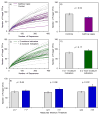Next-generation DNA sequencing reveals that low fungal diversity in house dust is associated with childhood asthma development
- PMID: 24883433
- PMCID: PMC4048861
- DOI: 10.1111/ina.12072
Next-generation DNA sequencing reveals that low fungal diversity in house dust is associated with childhood asthma development
Abstract
Dampness and visible mold in homes are associated with asthma development, but causal mechanisms remain unclear. The goal of this research was to explore associations among measured dampness, fungal exposure, and childhood asthma development without the bias of culture-based microbial analysis. In the low-income, Latino CHAMACOS birth cohort, house dust was collected at age 12 months, and asthma status was determined at age 7 years.The current analysis included 13 asthma cases and 28 controls. Next-generation DNA sequencing methods quantified fungal taxa and diversity. Lower fungal diversity (number of fungal operational taxonomic units) was significantly associated with increased risk of asthma development: unadjusted odds ratio(OR) 4.80 (95% confidence interval (CI) 1.04–22.1). Control for potential confounders strengthened this relationship. Decreased diversity within the genus Cryptococcus was significantly associated with increased asthma risk (OR 21.0, 95% CI 2.16–204). No fungal taxon (species, genus, class) was significantly positively associated with asthma development, and one was significantly negatively associated. Elevated moisture was associated with increased fungal diversity, and moisture/mold indicators were associated with four fungal taxa. Next-generation DNA sequencing provided comprehensive estimates of fungal identity and diversity, demonstrating significant associations between low fungal diversity and childhood asthma development in this community.
Practical implications: Early life exposure to low fungal diversity in house dust was associated with increased risk for later asthma developmen tin this low-income, immigrant community. No individual fungal taxon (species, genus, or class) was associated with asthma development, although exposure to low diversity within the genus Cryptococcus was associated with asthma development. Future asthma development studies should incorporate fungal diversity measurements, in addition to measuring individual fungal taxa. These results represent a step toward identifying the aspect(s) of indoor microbial populations that are associated with asthma development and suggest that understanding the factors that control diversity in the indoor environment may lead to public health recommendations for asthma prevention in the future.
Conflict of interest statement
Figures



Similar articles
-
Indoor microbiota in severely moisture damaged homes and the impact of interventions.Microbiome. 2017 Oct 13;5(1):138. doi: 10.1186/s40168-017-0356-5. Microbiome. 2017. PMID: 29029638 Free PMC article.
-
Characteristics of annual mold variations and association with childhood allergic symptoms/diseases via combining surveys and home visit measurements.Indoor Air. 2022 Sep;32(9):e13113. doi: 10.1111/ina.13113. Indoor Air. 2022. PMID: 36168229
-
Metagenomic Characterization of Indoor Dust Bacterial and Fungal Microbiota in Homes of Asthma and Non-asthma Patients Using Next Generation Sequencing.Front Microbiol. 2020 Jul 30;11:1671. doi: 10.3389/fmicb.2020.01671. eCollection 2020. Front Microbiol. 2020. PMID: 32849345 Free PMC article.
-
Modifiable factors governing indoor fungal diversity and risk of asthma.Clin Exp Allergy. 2014;44(5):631-41. doi: 10.1111/cea.12281. Clin Exp Allergy. 2014. PMID: 24471926 Review.
-
Current insights into fungal species diversity and perspective on naming the environmental DNA sequences of fungi.Mycology. 2019 May 7;10(3):127-140. doi: 10.1080/21501203.2019.1614106. eCollection 2019. Mycology. 2019. PMID: 31448147 Free PMC article. Review.
Cited by
-
Indoor bacterial and fungal aerosols as predictors of lower respiratory tract infections among under-five children in Ibadan, Nigeria.BMC Pulm Med. 2022 Dec 9;22(1):471. doi: 10.1186/s12890-022-02271-w. BMC Pulm Med. 2022. PMID: 36494686 Free PMC article.
-
Childhood asthma and mould in homes-A meta-analysis.Wien Klin Wochenschr. 2025 Feb;137(3-4):79-88. doi: 10.1007/s00508-024-02396-4. Epub 2024 Jul 11. Wien Klin Wochenschr. 2025. PMID: 38992293 Free PMC article.
-
Complex genetics of pulmonary diseases: lessons from genome-wide association studies and next-generation sequencing.Transl Res. 2016 Feb;168:22-39. doi: 10.1016/j.trsl.2015.04.016. Epub 2015 May 7. Transl Res. 2016. PMID: 26006746 Free PMC article. Review.
-
Influence of housing characteristics on bacterial and fungal communities in homes of asthmatic children.Indoor Air. 2016 Apr;26(2):179-92. doi: 10.1111/ina.12205. Epub 2015 Apr 17. Indoor Air. 2016. PMID: 25833176 Free PMC article.
-
Pediatric Asthma and the Indoor Microbial Environment.Curr Environ Health Rep. 2016 Sep;3(3):238-49. doi: 10.1007/s40572-016-0095-y. Curr Environ Health Rep. 2016. PMID: 27230430 Review.
References
-
- Agarwal R, Gupta D. Severe asthma and fungi: current evidence. Med Mycol. 2011;49:S150–157. - PubMed
-
- Akinbami LJ, Moorman JE, Bailey C, Zahran HS, King M, Johnson CA, Liu X. NCHS Data Brief. Vol. 94. Hyattsville, MD: National Center for Health Statistics; 2012. Trends in Asthma Prevalence, Health Care Use, and Mortality in the United States, 2001–2010. - PubMed
-
- Akinbami LJ, Moorman JE, Liu X. National Health Statistics Report. Vol. 32. Hyattsville, MD: National Center for Health Statistics; 2011. Asthma Prevalence, Health Care Use, and Mortality: United States, 2005–2009. - PubMed
Publication types
MeSH terms
Substances
Grants and funding
LinkOut - more resources
Full Text Sources
Other Literature Sources
Medical

